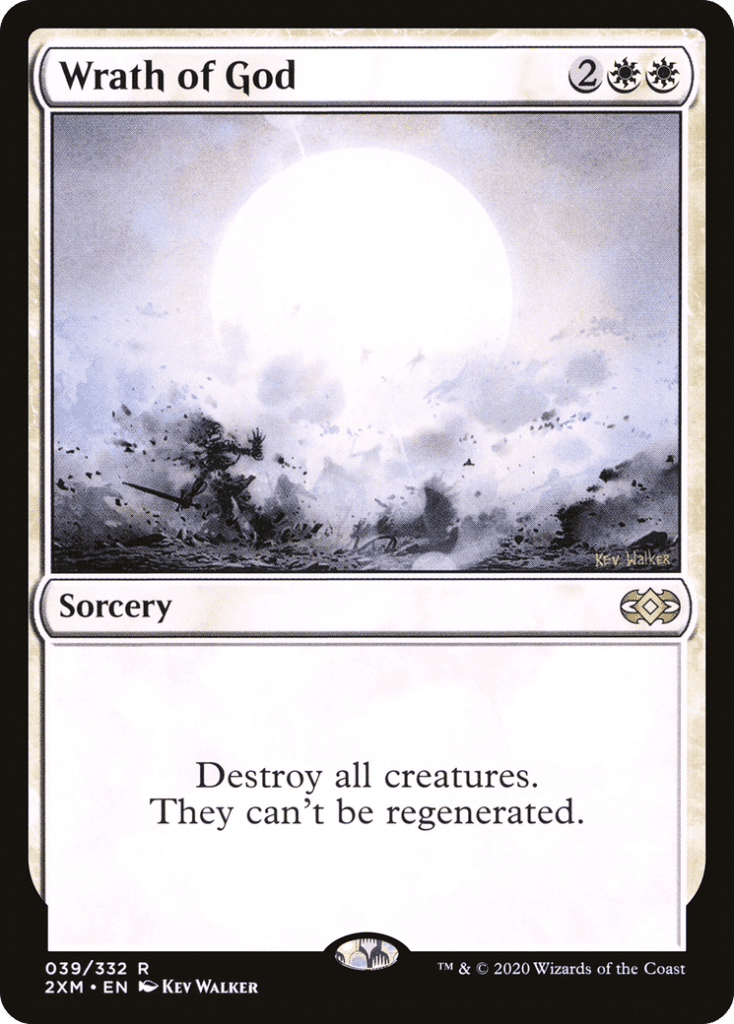
Each color in Magic: The Gathering‘s color pie excels at certain tasks, performing them far better than any other. For example, green is the best at mana ramp, black is the best at tutoring, blue has the best countermagic, red gets the best burn spells, and white is the best at mass removal (also referred to as board wiping).
This often makes narrowing down the cream of the crop for certain cards in these colors extremely difficult, as you have access to the largest pool of options, many of which are good enough to be considered top-tier if they existed in another color.
White’s board wipes are no exception to this analysis paralysis. There are so many good mass removal options, you can find one tailor-made for virtually any strategy, metagame call, or type of permanent your heart desires, making what is “best” far from universal.
How Do White’s Best Mass Removal Spells Work?
White has many options for destroying, exiling, sacrificing, and tucking most or all permanents of one or more types. While mass removal spells that destroy permanents tend to have the lowest mana costs, there is no shortage of cost-effective options for removing indestructible cards or making a board wipe much more one-sided for specific decks.
Ultimately, since there are so many mono white board wipes that are designed for specific strategies or situations (particularly at 5 mana), this means those that are going to have the most universal appeal are going to be those that have lower mana costs and/or offer the highest return for the mana you spend.
While individual entries are going to be arranged loosely from worst to best and certain types of board wipes are going to be grouped separately, most of the cards that are going to be discussed are very playable in most white decks. Those that aren’t are more mechanically unique, and will generally see play as metagame calls or in specific decks, if at all.
Additionally, while we’re going to look at a lot of different cards, there are going to be lots of other good board wipes in white that don’t get a spotlight in this article – it’s never a bad idea to hit up Gatherer or Scryfall to see what other options are out there for your deck.
Tribal Board Wipes (Angel of Glory’s Rise, Celestial Kirin, Harsh Mercy, Tivadar’s Crusade)

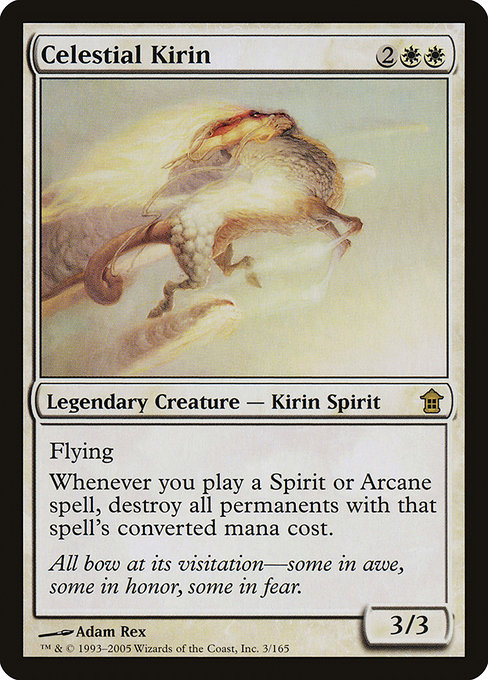
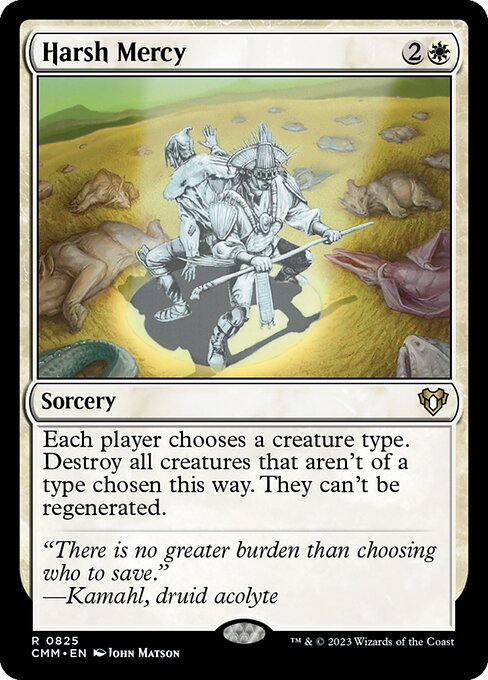
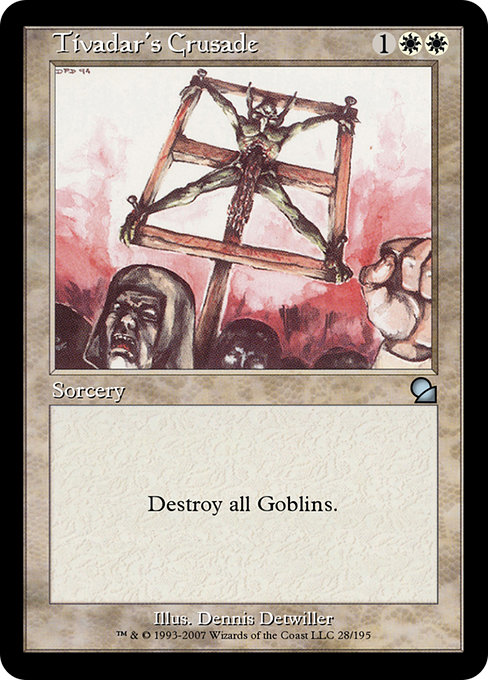
Tribal board wipes in white can work a couple different ways. Some synergize with creature tribes, such as Celestial Kirin‘s destructive trigger when playing Spirit or Arcane spells, or Harsh Mercy‘s ability to clear most opposing creatures at an incredibly efficient 3 mana rate while leaving the caster’s own board completely untouched in tribal decks like Slivers.
The other route tribal board wipes tend to take in this color is more conventional – removal of a specific type of creature on the battlefield.
Generally, you’ll only play cards like Angel of Glory’s Rise and Tivadar’s Crusade as specific answers to a problem in your metagame, as they aren’t likely to be very effective on their own merits despite targeting 2 very popular creature tribes.
If you’re really tired of Krenko, Mob Boss or The Scarab God singlehandedly swarming the battlefield though, the effect of these tribal board wipes in specific matchups can be incredibly surgical and disproportionate.
Color Hosers (Martyr’s Cry, Major Teroh, Ravnica at War)
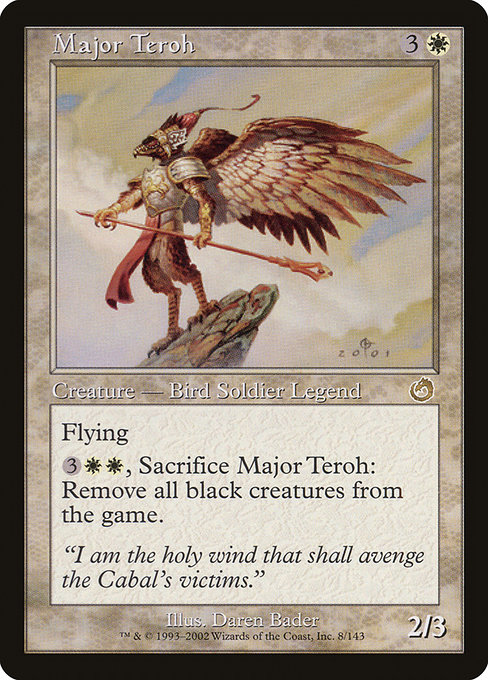
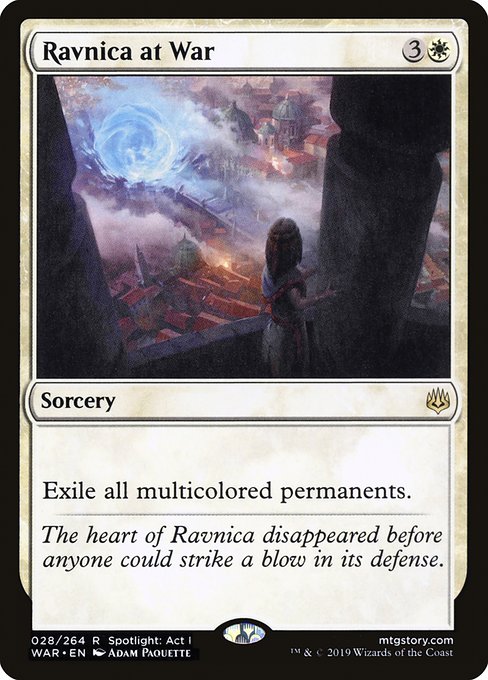
Board wipes that target specific colors tend to have very interesting effects compared to normal board wipes. Most were printed in the early years of Magic before card design became more standardized, and color hosers were relegated to reprints or had weaker abilities like Protection and Hexproof starting in the mid-2000s.
Take Martyr’s Cry as an example. This card exiles all white creatures in play for 2 mana, which while a great rate for a board wipe, is a little odd to see on a white card.
While apparent it is intended for use on your own creatures to reinforce your hand, multicolor creatures (including the legendary ones used as Commanders) are far more common these days, giving a card like this considerable reach compared to when it was originally printed in The Dark.
Major Teroh‘s effect, on the other hand, is much more straightforward. Pay 5 mana once it’s out, and all black creatures on the battlefield are exiled at instant speed. While I ordinarily wouldn’t find the prospect of a 9 mana board wipe interesting, Major Teroh is legendary, so you could arrange to have access to this powerful effect in your command zone.
Naturally, the effectiveness of doing this will vary depending on the decks you are playing against, but in a 4 player game, the odds of being able to keep at least 1 player’s board in check with this exile effect are pretty good. In a worst case scenario, Major Teroh is also a Soldier with evasion, affording it access to some decent tribal support.
Perhaps most surprising among these cards is Ravnica at War. It hadn’t occurred to me when War of the Spark released just how unusual seeing such a blatant color hoser, ever one that paints in such broad strokes, truly was in this day and age.
Ravnica at War is also a pretty solid card, as at minimum it will exile most commanders, and it will often pick up several other problematic multicolored permanents along the way.
Enchantment Board Wipes (Cleansing Meditation, Paraselene, Patrician’s Scorn)
When you need to get rid of several obnoxious enchantments at once (looking at you Rhystic Study, Ghostly Prison, Smothering Tithe, and Doubling Season), few colors or color combinations do the job as well as white.
Patrician’s Scorn is probably the most commonly played among these three cards. Spells that can be played for free frequently see tons of play across multiple formats, and when the only condition for that free cast is to play another white spell, you’ve usually got a winner unless the effect is really mediocre.
Especially when you can cast it at instant speed.
Cleansing Meditation is arguably the most powerful enchantment board wipe in mono white. Threshold is relatively easy to get and maintain during most Commander games, ensuring you’ll almost always get a very one-sided board clear when you need to cast it.
While Paraselene is relatively underwhelming compared to these other two enchantment sweepers, but any time you can get a decent side benefit out of a mass removal spell without having to pay more for it, it’s worth paying attention to. Who knows, that 3-5 life might end up being the difference between winning or not!
Artifact Board Wipes (Consulate Crackdown)
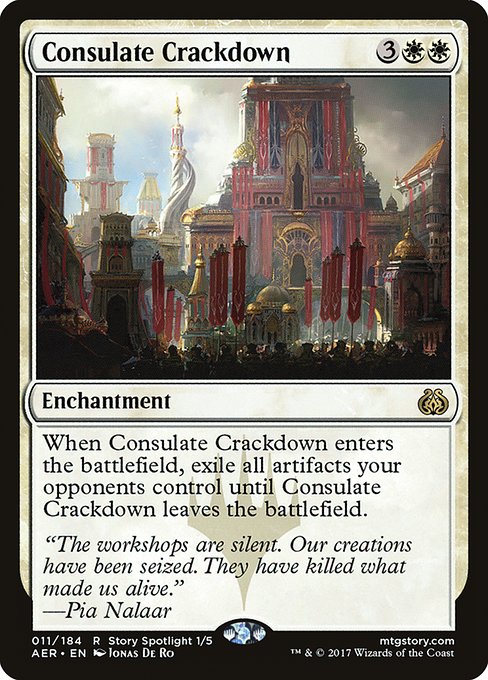
I’m always surprised by how few strictly artifact board wipes there are in colors where I expect to see a bunch of them, but Consulate Crackdown is somehow the only one. Regrettably, it’s also not a great option when compared to board wipes that are modal or hit both artifacts and enchantments.
The fact that Consulate Crackdown exiles is worth noting, as there are plenty of indestructible artifacts that see play in Commander, but Oblivion Ring effects tend to only delay the inevitable.
When they get destroyed, you’re almost always going to find yourself looking for another answer and wondering why you didn’t play a more effective removal spell in the first place.
Artifact and Enchantment Board Wipes (Dismantling Wave, Serenity, Purify)



As someone who really enjoys value, Dismantling Wave is one of my favorite removal spells printed in recent memory. 3 mana to Disenchant every opponent at the table is always incredibly useful, and while I very rarely use the cycling effect as a board nuke, the times I’ve needed it have been instrumental for closing out a game.
Nothing against Serenity and Purify – I’ve played enough copies of Planar Collapse and Cleansing Nova (more on them in a bit) to understand how good these cards are too.
Unfortunately, Serenity tends to work against many of the decks I’d want to use it in, as it conflicts with key artifact and enchantment cards, and Purify just doesn’t have the flexibility many newer board wipes have at a similar mana cost.
That said, repeatedly bringing back a Serenity with Sun Titan or blinking an Eternal Witness to return it to my hand sounds like the type of fun I could get behind. 2 mana is an absurdly good rate for a board wipe, even if you have to telegraph it to the table and wait a turn for it to go off.
Mass Land Destruction (Armageddon, Global Ruin, Ravages of War, Fall of the Thran)

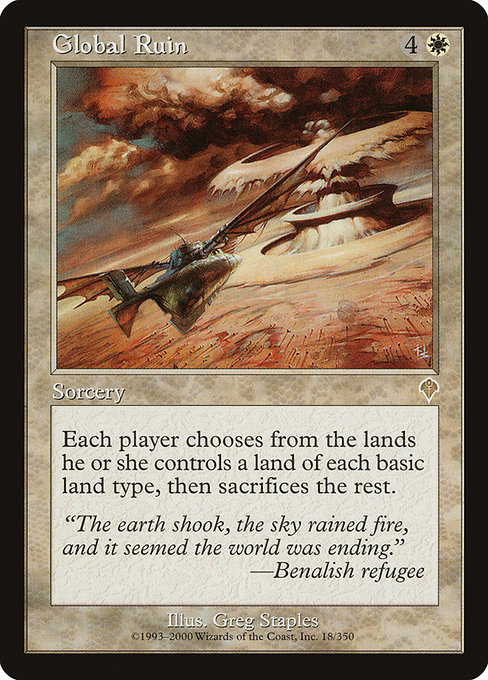
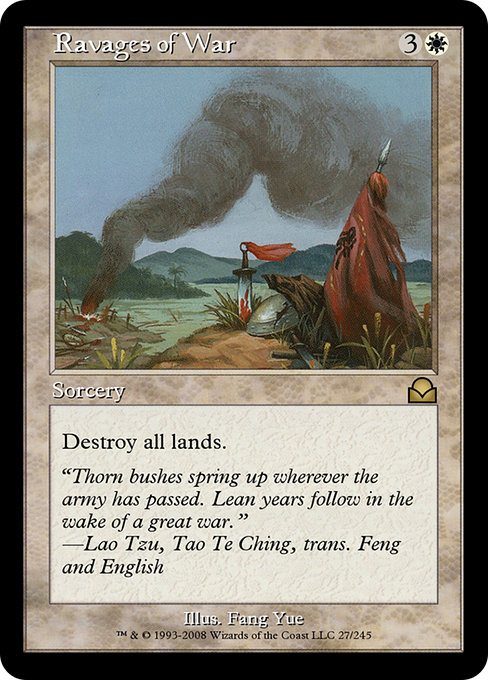
Nothing kills the joy of a Commander table quite like mass land destruction, and during the earliest days of Commander (back when it was EDH), Armageddon was in nearly every white deck I played and played against due to its low mana cost, affordable price point, and raw power.
Players who knew how to make the most of Armageddon‘s board shattering potential were usually poised to win the game upon its resolution. It’s hard to retaliate against a winning board when you don’t have any mana, after all.
Spiteful players who were behind on lands or chaotic souls who played the card “just because” succeeded in doing little more than prolonging the game an extra hour or more while annoying the rest of the table.
While these were the moments that eventually moved mass land destruction away from mainstream play, this card’s influence on Commander’s social contract is an indelible part of the format’s history.
Ravages of War is effectively a second copy of Armageddon, but the only copy I ever came across in person back then was $50 in the late 2000s, and as a poor college student, that was simply more than I was willing to spend at the time.
While I eventually did pick up a judge promo years later, there really aren’t that many copies in circulation as the original printing of Portal Three Kingdoms didn’t have a large print run. If you need a second mass land destruction effect, however, it’s the definitely the most efficient option in terms of mana cost.
Global Ruin and Fall of the Thran are both acceptable alternatives if you don’t have either of the other cards, but the difference between 4 mana versus 5 or 6 is huge if you’re trying to play a sizable threat on the same turn as your land nuke, and both are likely to leave at least a few lands in play when all is said and done.
Modal Board Wipes (Austere Command, Catastrophe, Cleansing Nova, Farewell)
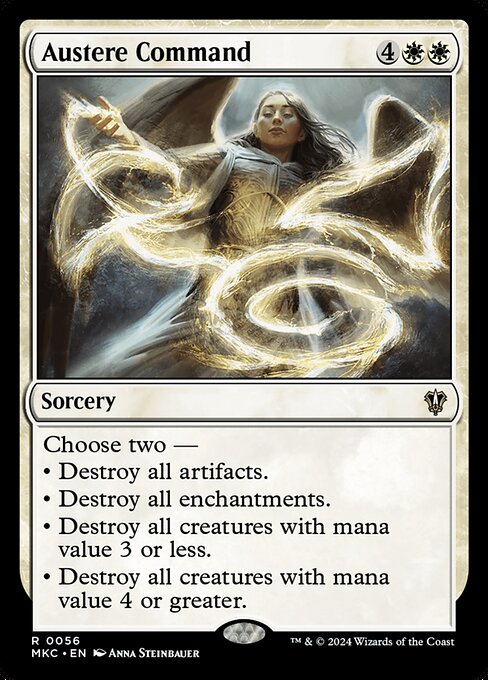
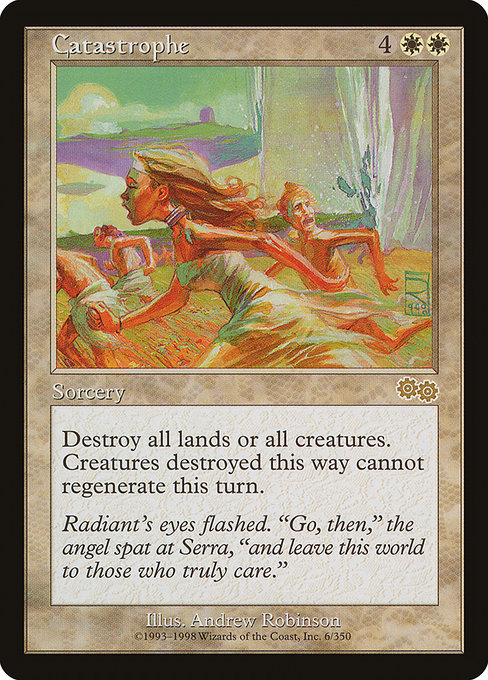
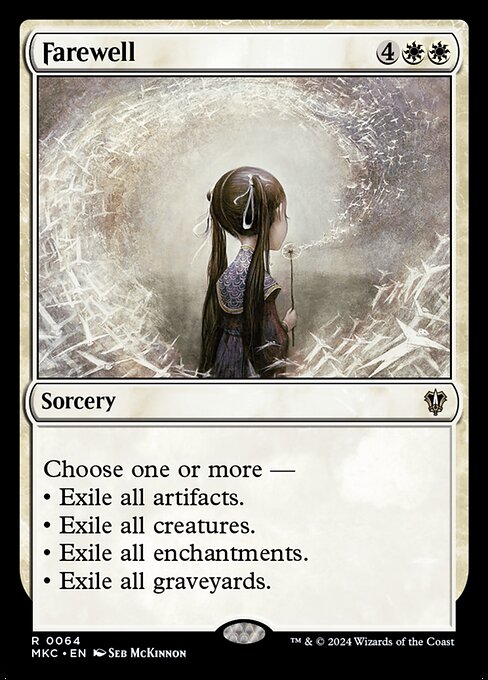
Much like Armageddon, Catastrophe was in a lot of early “competitive” EDH builds, as it could either help you clear creatures if you fell behind or set up a win if you used its mass land destruction effect. Fast forward a dozen years, and it’s nowhere to be found, as the format has sped up considerably and there are just more reliable ways to win than there used to be.
Austere Command was also an early staple, and while it doesn’t see nearly as much play as it used to, its unique modal effects for nuking the board have actually kept it in quite a few decks. I personally use it a lot with commanders like Karlov of the Ghost Council, as clearing high mana value creatures while leaving my extremely dangerous commander in play is ideal.
While Austere Command‘s play was already declining around Cleansing Nova‘s release, this card basically usurped the staple spot Austere Command held for years. The difference a single point makes in a card’s casting cost is always far larger than you might think at first glance, and while the modes aren’t as flexible, the utility is almost as effective most times.
Farewell elects to take a slightly different approach than other modal board wipes before it, giving you the ability to exile as many or few common permanent types as possible, notably excluding planeswalkers and lands.
The ability to exiles graveyards is also a solid modal option to tack on – many players overlook their impact on gameplay, so any card that raises awareness of how important it is to answer graveyards during a Commander game is all right in my book.
Board Clears that Clear Multiple Permanent Types (Cataclysm, Devastating Mastery, Hour of Revelation, Urza’s Ruinous Blast)
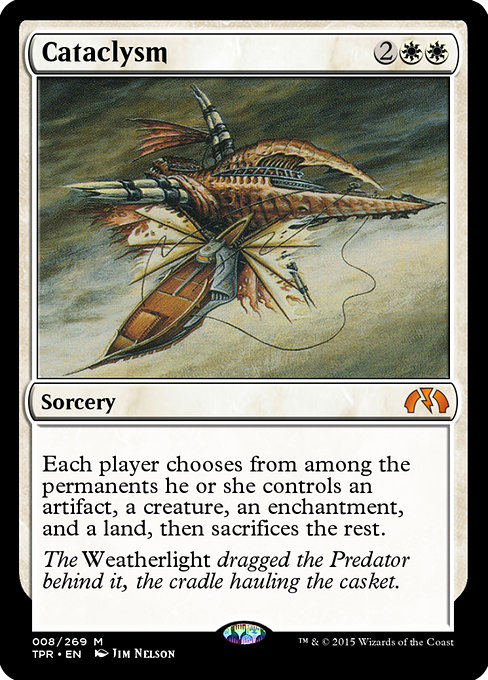
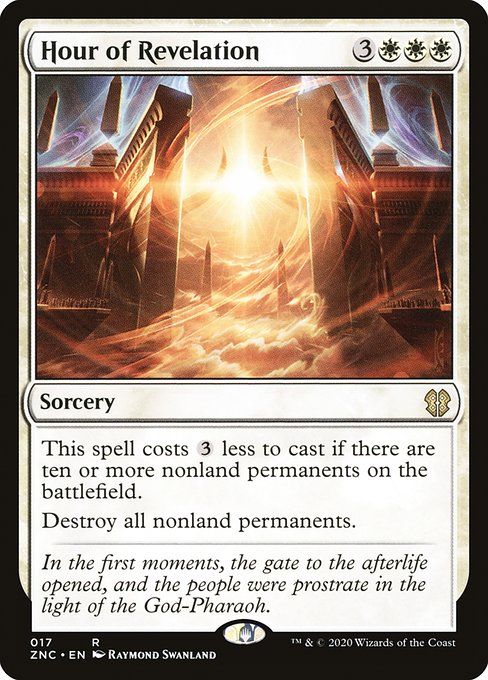
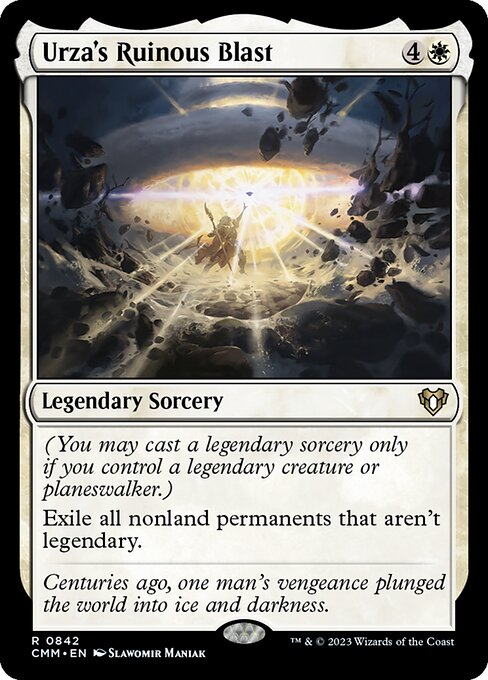
While Catastrophe was adopted by many in the late 2000s, Austere Command wasn’t the card that unseated it in my area – Cataclysm was. Turns out if you have the best 4 permanents compared to your competition and don’t want to be bothered by trivial keywords like indestructible, sacrificing most of the board for 4 mana is an incredibly efficient way to win.
Thankfully, Cataclysm started disappearing from mainstream view around the same time as Armageddon, though you’ll still periodically see it live on in tamer descendants like Cataclysmic Gearhulk, which while obnoxious, ignores lands.
Devastating Mastery and Hour of Revelation are testaments to the sheer power of cost reduction mechanics, especially when they’re attached to cards with powerful effects.
Hour of Revelation at least has a condition for reducing its casting cost, but getting 10 nonland permanents on the battlefield in a 4-player pod takes zero effort on your part. Mana rocks are common in early turns, meaning this board wipe could be live and relevant as early as turn 3 while still being useful at any other point in the game to clear an ugly board state.
Devastating Mastery doesn’t even make you jump through a hoop to reduce its cost by 2 white pips – just give the opponent who is furthest behind a chance to retrieve up to their 2 best nonland permanents (assuming they even have any) before clearing all nonland permanents from the battlefield. No wonder Wrath of God sees such little play these days!
My personal favorite among these full board sweepers is Urza’s Ruinous Blast. While having a legendary creature or planeswalker in play is sometimes an annoying casting prerequisite, exiling all nonland, nonlegendary permanents will often leave you in a commanding board position when timed correctly – especially if your deck revolves around legendary permanents.
Meeting the prerequisite for casting a legendary sorcery is at least easy, as you’ll always have access to a legendary creature or planeswalker in your command zone. Just remember that everyone else will too, so you might still have to address a few threats on the table after this spell resolves.
Winds of Abandon
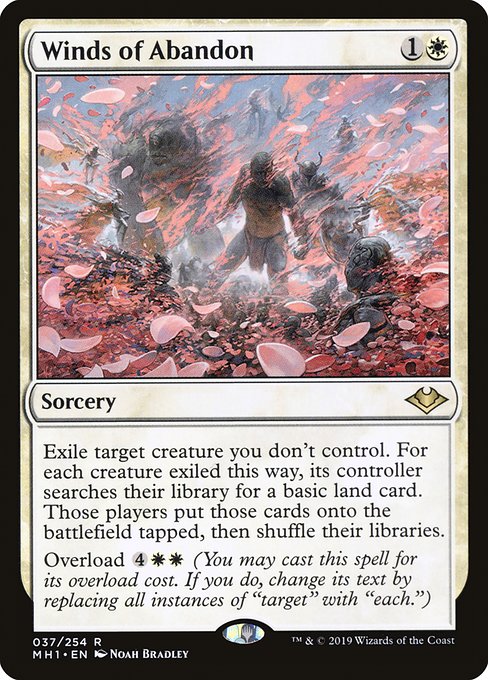
Winds of Abandon is a card I expected to see as often as Cyclonic Rift when it released in Modern Horizons, as board wipes that strictly clear your opponents’ threats are always incredibly powerful cards in multiplayer formats like Commander.
This hasn’t worked out in practice, largely due to this board wipe’s sorcery speed and the specific tradeoff it presents. There’s a big difference between clearing away all threats right before you untap and playing a 6 mana board wipe after, as you usually won’t have much mana left for follow up plays.
Add in the fact that your opponents are probably going to be getting a lot more mana to rebuild with afterward, and this card loses much of the appeal Cyclonic Rift offers, as you are put in a position where you feel like you have to win during the turn you play it in order to not fall behind in later turns.
Personally, I don’t think that’s quite a fair take either. Sure, a 2 mana sorcery speed Path to Exile or 6 mana board wipe, even one that exiles, isn’t going to impress many people on its own merits. But I’ve definitely seen games where each mode of Winds of Abandon has done a lot of work, and I’ve even won a few games thanks to it clearing a path for my creatures.
While this card doesn’t see a lot of play in my decks currently, that’s only because playtesting has helped me narrow down different board wipes that fulfill the needs of my white decks a little more effectively. It’s absolutely worth taking for a spin in pretty much any deck that can play it.
Terminus
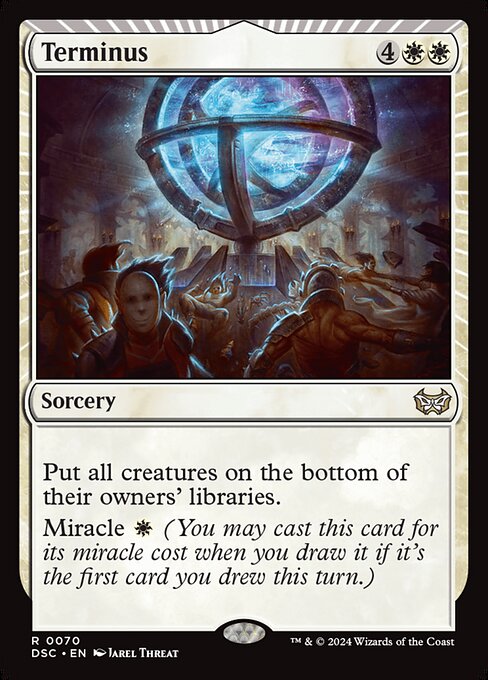
Tuck effects, or cards that placed creatures into their owner’s library, were another pillar of early Commander games. Back before you could choose to put your commander into the command zone when it was headed to your library with a replacement effect (a rules change that occurred on March 23, 2015), tucking a commander was a very common way to permanently answer it.
While this rule update cratered the usefulness of cards like Hinder, Spell Crumple, and Condemn in the format, Terminus and Hallowed Burial continued to see common play for some time, as they were an effective way to ensure indestructible creatures didn’t survive your board wipe.
Both are still good cards to this day, but Terminus has a lot more going for it thanks to its Miracle ability. Being able to board wipe for a single mana, even at instant speed, just by drawing Terminus as your first card for the turn has upset many a game, and when done on your turn, still leaves most of your mana open to immediately rebuild.
You don’t simply have to rely on “The Heart of the Cards” to take advantage of this steep cost reduction either. Mystical Tutor, Sensei’s Divining Top, Sylvan Library, Vampiric Tutor, and Scroll Rack are but a few of the accomplices that have been used to score an extremely cheap board wipe over the years, each ensuring Terminus is ready and waiting the turn you need it.
All of these cards see a lot of Commander play on their own merits anyway, so there really isn’t going to be a significant deckbuilding cost to add such a combo to many decks if you need a specialized board wipe to deal with indestructible threats.
Retribution of the Meek
3 mana board wipes are almost always worth looking at in Commander, but Retribution of the Meek has a tendency to fly under the radar. Perhaps it’s because of the scarcity created by its inclusion on the Reserved List, maybe it’s because the format evolved to the point that clearing creatures with power 4 or greater is perceived as not doing enough.
Personally, I don’t agree with the latter take. Yes, there are a lot of powerful creatures in the format who have less than 4 power, and yes, there are board wipes that clear far more permanents for a comparable mana cost.
But for many Commander decks, especially those who play a lot of low power creatures themselves like Arcades, the Strategist or those that want to play board wipes with a low mana cost that don’t hit noncreature permanents like Zur, the Enchanter, Retribution of the Meek is an overlooked gem.
Planar Collapse
Planar Collapse is mechanically similar to Serenity in many respects, as it has a very low mana cost, triggers on your upkeep, and delivers a stellar effect in exchange for waiting a turn cycle to go off. Despite its conditional upkeep trigger, however, I have found the creature board wipe to be far superior to the artifact and enchantment version.
In fact, the requirement that 4 creatures be on the battlefield for Planar Collapse to trigger is, if anything, a benefit. When you have the best creature on the battlefield when playing Planar Collapse, you effectively force your opponents to commit either an answer to the creature, an answer to the enchantment, or more creatures to the battlefield to trigger your card.
When played in enchantment decks that utilize a lot of recursion through cards like Starfield of Nyx or Replenish, you can transform this awful decision into a certifiable nightmare for your opponents, as they’ll use up their ways to address a recurring creature wipe without an exile effect.
If playing the same card ad nauseum isn’t your strategy of choice, Planar Collapse is also just a solid inclusion for a lot of decks that need a cheap board wipe.
While it admittedly can put a target on your back if someone is really far ahead of the rest of the table, waiting a turn generally isn’t a big deal during most deadlocks or stalemates. Planar Collapse can also discourage explosive early turns, as many players will hold off on committing creatures to the board until it goes off, allowing you some say in dictating game tempo.
Sure, your enchantment might eat a piece of spot removal before it goes off, but most people tend to run fewer answers for enchantments than other types of permanents, which results in Planar Collapse successfully destroying all creatures in play more often than not. Even if it simply slows combat potential for a couple turns, it has done its job well.
Settle the Wreckage

I. Love. This. Card. Settle the Wreckage is everything I thought Winds of Abandon would be, and it has pulled me back from the brink of defeat more times than I can count. Your opponent’s creatures don’t even have to be attacking you for you to blow them out of the water, making it a very useful card in many more scenarios than you might expect.
While I’ve already touched on the problems of ramping your opponents if your Commander game goes on for several more turns after a board wipe like this resolves, Settle the Wreckage doesn’t really put you behind in the same way, as you’re only ramping one player rather than everyone as with Winds of Abandon.
If that player is poised to get out of hand afterward, rallying your other opponents to cooperate with an effort to bring the player you ramped down is rarely a tough sell because you probably exiled several creatures that were of greater concern in the moment, which tends to make your case look pretty favorable afterward.
Best of all, nobody is really prepared for a Settle the Wreckage when it goes off. While it was all over Standard a few years ago, nobody really seems to think much of 4 open mana in Commander these days, so when someone swings all out thinking they have the game won, this card firmly plants them at the back of the pack where they won’t be able to recover.
Settle the Wreckage is also an instant, so you’ll usually have a free turn to retaliate while your victim’s shields are down without necessarily having to tap out yourself. Just keep an eye on what your other opponents are doing so you don’t get blown out by another Settle the Wreckage during your moment of triumph.
Dusk // Dawn

When working on a Commander deck, you never know when you’re going to reach a “level up” moment that shifts the way you play Magic forever. I was tuning up my mono white Equipment deck, looking at the board wipes I was running and came to a realization:
Dusk // Dawn is better than Wrath of God.
This blew my mind at the time, as I’d been blindly auto-including Wrath of God in every white deck I played for years. This iconic board wipe had always done so much work for me at such a reasonable rate across several formats. How is it possible that a card managed to usurp its position with such little fanfare from the MTG community?
And yet it did. Destroying all creatures with power 3 or greater is usually enough to clear all serious threats from the battlefield, and having the ability to retrieve all your utility creatures from your graveyard on a later turn for 5 mana is a great way to refill your hand when you’re starting to run on fumes. Especially in a color not known for card draw effects.
Times change. The old guard eventually retires. Evolving with these changes and challenging your assumptions is essential for growth in many aspects of life, and Magic is no exception.
Definitely a lesson I’ll keep with me for life.
Vanquish the Horde

An 8 mana board wipe that almost always casts for 2 is very reminiscent of Blasphemous Act, the best red board wipe ever printed for multiplayer formats. I don’t have anything new to say about Vanquish the Horde that I didn’t already say about Blasphemous Act in my article covering Commander’s best red board wipes – this card is insanely efficient at what it does.
Yet I see the same slow adoption of this card in Commander decks locally. I know white has infinitely more options to sift through than red when it comes to clearing a board, but an unconditional 2 mana creature nuke you don’t have to jump through any hoops for is among the best possible rates in Magic, and is only beaten out by Terminus when Miracled.
If you need a board wipe for creatures, and you’re playing white, you should be playing Vanquish the Horde in most cases. End of story.
How Many Board Wipes Should I Play in Commander?
There’s not a hard and fast answer to this question, as the needs of different Commander decks can vary quite a bit from strategy to strategy. 4 is usually a good starting number to play in your Commander deck, but decks without many creatures may run 2-3 times that to minimize the presence of opposing creatures.
White decks also have the highest amount of flexibility when it comes to choosing their board wipes. Cleansing Nova, Vanquish the Horde, and Dusk // Dawn are usually where I’ll start when considering mono white board wipes, then I’ll usually aim for 1-3 others that can hit multiple permanent types, such as Austere Command or Hour of Revelation.
From there, I’ll do some testing and adjust the board wipes I use as I learn the different lines of play for my deck, the problems it struggles most to overcome, and the types of permanents I don’t want to destroy on my own battlefield when addressing my opponents’ threats.
I’ll usually wind up with 4-6 board wipes after several games that I’m happy with, and then I’ll continue to adjust as my deck and local metagame evolve. New cards are coming out all the time, so if you see a card that has the potential to be good in your deck, don’t be afraid to try it. You might be surprised by how much better a slight variation on the same effect can be.
Other MTG Articles You Might Enjoy
- Good Red Commander Board Wipes
- Mono White Ramp Spells for EDH
- Best Green Ramp Spells for EDH
- MTG Black Tutor Cards for Commander
- MTG Green Board Wipes for Commander
- EDH Reanimator Commanders
Braden is a founder of Assorted Meeples and has been a gamer & writer with a vivid imagination all his life. Don’t believe us? Check out his excitement when meeting Goosebumps author R.L. Stine as a kid! An avid Magic: The Gathering spellslinger for over 15 years, you can always convince him to shuffle up for a game (or three!) of Commander.
